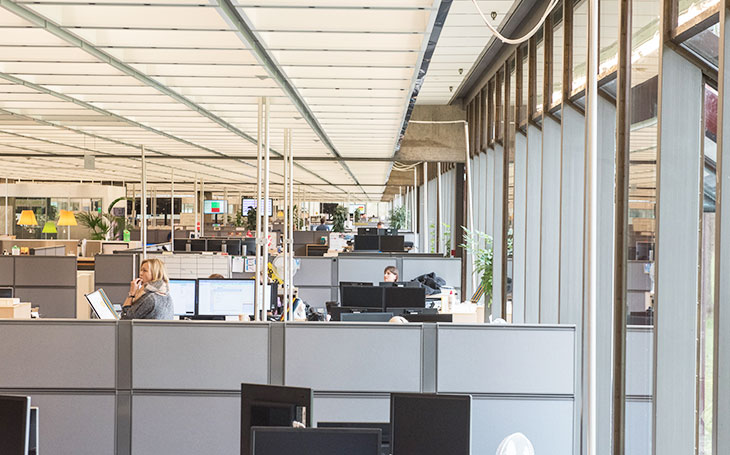
Regain your concentration in the open office space
You are sitting with your head buried in a task. A task that requires deep concentration and it’s finally going really smoothly.
Then your colleague’s phone rings and she starts chatting with her husband. You can’t help yourself but to listen to their conversation from the sideline, and suddenly you’ve caught yourself
listening for several minutes.
What were you doing before, again?
We can all relate to disturbances in the office. When the weekend’s events are being shared across the office, or when a colleague’s mobile vibrates every time a text or Facebook notifications
ticks in.
Noise and concentration problems
Today's modern open space office has especial disadvantages in noise management. No less than every other Dane who works in a open office space office is bothered by noise, shows a new
study from the National Research Center for the Working Environment. 60 percent say they find it difficult to concentrate in open office spaces. According to Jan Pejtersen, Senior Researcher at t
he National Research Center for the Working Environment, there are several sources of noise in the open office landscape."People typically complain about noise and lack of privacy. It's
especially hearing other people talking and ringing phones that disturbs people," says Jan Pejtersen.
A new survey which includes 2,300 office workers from 22 offices shows that employees in open office environments are more likely to
experience concentration problems, as well as problems with indoor climate and the noise level. And the bigger the office, the bigger
the problem.
White Noise as a solution
The large Danish insurance company Topdanmark, which has been established in one of the largest open office spaces in Scandinavia
since 1974, isn’t part of the problem. At least, it’s not if you ask them. Along with various noise reduction initiatives, they have had
White Noise implemented since they moved into their 11,000 m2 open office, 43 years ago. “It is being called ‘colored noise’ and,
paradoxically, you use noise to control the noise level. In our office we have more than 500 speakers installed in the celling that emit a
sum and muddy the sound image,” says Martin Arildslund, Rental Manager at Topdanmark.He points out that it doesn’t lower the sound
level, but makes you unable to decode what your colleagues next to you are talking about. With White Noise, you won’t listen to your
colleagues' conversations and lose focus.
"It doesn’t mean that we can’t experience noise problems, but the employees feel comfortable working in the office. If there is chaos,
our white noise technology does not work for a short period of time. It's a good indicator that in general, it’s useful to staff.
When we get external visitors, they’re very excited and surprised at how comfortable the sound level is, despite the fact that the office
space is work base for 980 employees and is one of the largest in Northern Europe,” he adds.
Acoustics, quit rooms and behaviour
Implementing white noise in a packed office can, according to the rental manager, have its clear advantages. But on the other hand, it may also have a counterbalancing effect, even if the
number of employees is small. "If you're sitting in an open office space with just a handful of employees at work, where they mainly do sedentary work, white noise will very soon be ventilation
noise rather than noise regulation.
“It is also important that you see white noise as part of your acoustic initiatives, and it is important to communicate that throughout the organization. If the employees think it will make the
office completely silent, they will be very disappointed,” emphasizes Martin Arildslund. In addition to White Noise, the market can offer several other solutions to reduce the noise level.
6 useful tips:
- Arrange desks so that employees with a natural working community are in close proximity.
- Buy noise reducing headphones such as those offered by Bose to the writing staff, or those who often need silence while working
- Make sure the employees have the opportunity to go somewhere quiet where they can immerse for a longer period of time. Silence rooms or meeting rooms are a good way to do this.
- It can also be a good idea is to design the office with lounge areas where the employees can go to talk one and another, away from others who are working.
- Consider buying acoustic panels in the celling, on walls and eventually close to individual workstations.
- Set a few rules at the office. For example, employees should forward their phones, so if they are not sitting by your desk then their phone doesn’t interrupt others. You can also agree on signs that signal that you would like your colleague to lower their voices. It’s a good idea to make it normal to comment on each other’s behaviour and perhaps decide that if you want to chat with a colleague, then you ought to go to a lounge or other social area in the office, where you don’t disturb others.


